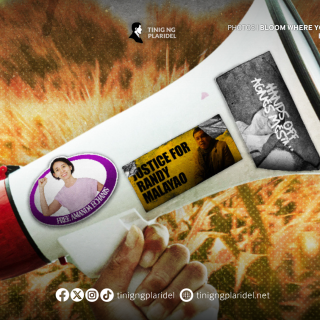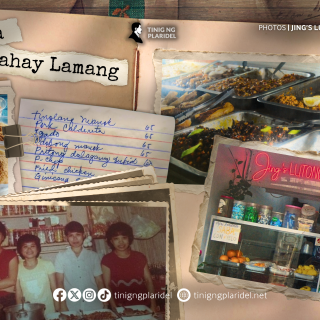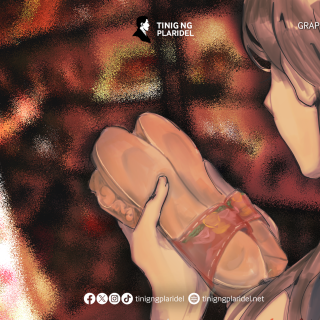TRIGGER WARNING: This article contains mentions of sexual violence and rape.
Like its muses, Memory Project 21 finds itself in the midst of Philippine history.
The audience looks on at the bronzed, blindfolded Filipina Comfort Women statue flashed onscreen, but so do the polymer desaparecido sculptures down the hall. So does the multicolored archipelago-like installation, the chromogenic print snapshots of Filipino life.
The Memory Project 21: Filipina Comfort Women and the Continuing Quest for Justice talkback panel runs in parallel with the Locations of Freedom exhibit.
History unfolds to reveal multiple narratives, coinciding like chapters of one anthology, not to drown each other out but to attest to the nonstop pace of life.
This much is true in the Philippines, where, despite World War II ending with Japan’s formal surrender on Sept. 2, 1945, the plight of Filipino comfort women continues to run on a different clock.
Held captive inside brothels during the Japanese occupation, Filipino comfort women were forced to satisfy the sexual desires of Japanese soldiers. Years later, both the Japanese and Filipino governments dangle justice teasingly over the victims’ heads. The call for reparations now searches constantly for an avenue more obliging than its oppressors.
This sense of urgency found a place in Memory Project 21: Filipina Comfort Women and the Continuing Quest for Justice, hosted at the UP Fine Arts Gallery (Parola) on Sept. 3 by the Concerned Artists of the Philippines to commemorate the 80th anniversary of the 1945 events.
Amidst the many stories simultaneously being told, a collective voice evidently commands attention — the challenge now is maintaining it.
“Kung [hindi] na mainstream ang usapin, sino ang makakaalam? Sino ang susuporta?” Probe Archives Head Julie Nealega asked.
Time has become the consistent thorn in keeping conversations about the Filipino comfort women alive. If not the race to bring justice nearer to survivors before they pass on, the survivors themselves may personally choose to put off opening up to others about their experiences.
Witness to this is Elizabeth Atillo-Dy, who recounted only finding out about her mother Estelita Dy’s experiences as a comfort woman when she saw her rallying at the Japanese Embassy.
What we risk against time, however, we win with documentation. Through documents showing the Japanese military’s guidelines for treating its sexual victims, the comfort women system reveals itself as “institutionalized,” coined by Assistant Professor Sol Iglesias of the UP Department of Political Science.
Sexually enslaving Filipino women was no accident. Rather, there was a method to the malevolence, a deliberate decision by the Japanese military to perceive the women as less than human.
In contrast, in each exchange between the Memory 21 panel and audience, the comfort women were consistently and affectionately called lolas. As the event began with a showing of “Healing the Wounds,” an archive from 1992 about comfort women, stories of survival came from the voices of the lolas themselves.
Now with names and faces (a birthright not even afforded to them by history books if they choose to come out publicly), the lolas are celebrated as strong women — not solely because they powered through pain, but also because their strength is inherent.
Both then and now, a woman’s word is the sparkplug of both commemoration and change; Memory 21’s very panel is already an embodiment of this.
Even then, Lila Pilipina Executive Director Sharon Cabusao-Silva acknowledged those who came before them: the first South Korean comfort women who shared their stories and inspired their Filipino counterparts to do the same, and the mothers of Filipino comfort women who often served as their daughters’ only confidants.
“The rest is herstory,” Cabusao-Silva declared.
Unfortunately, herstory has been hard-earned.
The lolas have found themselves forced into the footnotes of wartime stories, even as they wrestle the pen out of the hands trying to muffle them. They still have to prove themselves worthy of their own narratives, due to what Cabusao-Silva calls “denialism” from the Japanese government in accurately acknowledging and compensating for their offenses.
These lolas won’t go down without a fight, even as they grow old or are outnumbered. Their fight is fueled further whenever they call for justice together, whether in protesting at the Japanese Embassy or in forming organizations like Lila Pilipina.
READ: Women’s rights groups demand reparations for comfort women
Years passed, with so many lolas now gone, how do we let their memory be immortalized?
Better yet, how do we give their memory a life of its own? So that years later it may resound in halls that we ourselves no longer occupy, for an audience that lives in a timeline marked by scars different from ours?
The panel offered different answers, but the medium that prevailed in all of them is art.
And so, as Cabusao-Silva reminisced, tapestries crafted by the lolas themselves stay at the Lila Pilipina office. Episodes on comfort women, whether from a 33-year-old documentary or a recently concluded GMA series, find audiences wherever and whenever they go on air. Commemorative statues never go unnoticed, even in their forced absence.
Such an art piece will hold the lolas’ hands in its own forever — either by being the lolas’ own work or by reaching out to them during or after the production process.
The hands that made such pieces were therefore not forced; rather, they were set into motion by the desire for justice.
Through art, one keeps this desire tangible, easily transported throughout time. One captures this desire in a single place, as if to say in the spirit of the lolas, “On this earth, I once existed. On this canvas, I will exist forever.”
What do we do with eyes enlightened on the gaps left in history, ears that pick up on both the voices that spoke up and those that stayed quiet?
We create art that sticks to the senses.
We create art that honors and historicizes.












